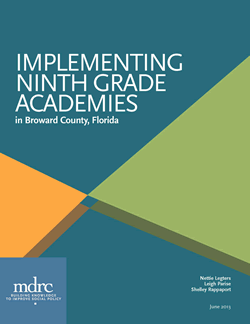Implementing Ninth Grade Academies in Broward County, Florida

With funding from the U.S. Department of Education’s Institute of Education Sciences, researchers from MDRC and Johns Hopkins University partnered with Florida’s Broward County Public Schools (BCPS) in 2009 to launch an independent evaluation of the district’s initiative to implement Ninth Grade Academies (NGAs) in every district high school. An NGA is a self-contained learning community for ninth-graders that operates as a school within a school. With its own administrative leadership, space, faculty, and teacher teams, it is designed to offer ninth-graders a more personalized, engaging, and responsive learning environment. The willingness of BCPS leaders to partner with researchers on this study offered a unique opportunity to learn more about NGAs and provide a firmer base of knowledge to guide policy and practice.
The study found strong district leadership at the outset and widespread uptake of core NGA components across the 18 high schools in the sample. The investigation also uncovered substantial variation in the overall quality and duration of NGA implementation across schools, however, with strong and sustained implementation of multiple components occurring in just three schools, even though many more had access to models of strong NGAs nearby. These implementation experiences in BCPS suggest that many schools will need more specific guidelines, on-site support, training for teachers, secure resources, and tools to guide practice and facilitate scheduling if they are to implement fully fledged, continuously improving, and self-sustaining NGAs.
Key Findings
- District leadership for the initiative was strong at the outset, but not sustained as district priorities changed.
- While schools received some support through a cross-school professional learning community for NGA administrators, they did not receive any other technical or financial support for program implementation.
- The district’s definition of NGAs focused on structural components in each school — ninth-grade administrative leadership, dedicated ninth-grade space, dedicated ninth-grade faculty, and interdisciplinary teacher teams. Improving ninth-grade curriculum, instruction, and student supports were not a direct focus of the initiative. In fact, other reforms in these areas aimed at improving student outcomes competed with NGA implementation.
- It was more feasible for schools to implement and sustain the administrative leadership and space components of NGAs than the dedicated ninth-grade faculty and interdisciplinary teaming components.
Only three high schools achieved strong implementation. Ten achieved a threshold level of implementation, and five fell below threshold. Most schools did not improve from the first to the second or third year.







